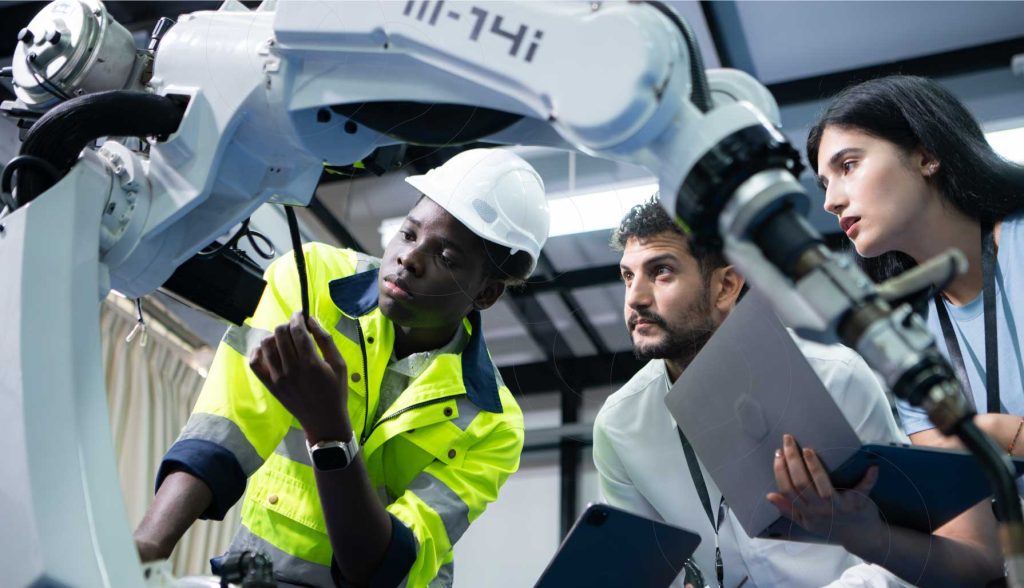Boost Efficiency with Intelligent Automation

In modern manufacturing, the implementation of Industry 4.0 and IoT scenarios is becoming increasingly important. A crucial tool for this is the concept of Factory Edge.
Driving Digital Transformation: KMU.DIGITAL 2025 supports small and medium-sized enterprises in Austria

In modern manufacturing, the implementation of Industry 4.0 and IoT scenarios is becoming increasingly important. A crucial tool for this is the concept of Factory Edge.
Efficient Manufacturing and Sustainability through Factory Edge: IoT and Industry 4.0 in Focus

In modern manufacturing, the implementation of Industry 4.0 and IoT scenarios is becoming increasingly important. A crucial tool for this is the concept of Factory Edge.
From Big Data to AIoT: Revolutionizing Business Processes with AI and IoT Integration

Big Data can be seen as one of the precursors of artificial intelligence (AI) because it provides the foundations and technologies required for the development and operation of AI systems.
We Compared 5 Email Hosting Solutions for your Business – 2024 Edition

If you’re looking for an email hosting service for your business, we’ve compared the top contenders in 2024 based on price, features, and user reviews.
Optimizing Your Technology Stack for Business Growth

In today’s dynamic business landscape, aligning your technology stack with your company’s growth strategy is more critical than ever. The concept of modular architecture is identified as a pivotal trend for digital transformation beyond 2023 and it redefines how enterprises function. 2023 has seen a transformative shift, with numerous leading organizations adopting a Total Experience (TX) approach. By enhancing the journeys of both customers and employees, these companies are creating extraordinary shared experiences while maximizing the utility of existing technology investments. The result is a significant boost in both customer and employee satisfaction, positioning the company to outperform competitors in satisfaction metrics by 2024. However, this shift towards a total experience approach also underscores the importance of seamless collaboration between IT and business teams. The traditional role of IT as a technology enabler has evolved, as it now plays a central role in addressing critical business challenges. This necessitates a closer working relationship between IT and business teams. At the core of delivering seamless digital experiences lies the pivotal role of your organization’s technology stack. Optimizing processes is a top priority. In the quest to streamline technology and make informed decisions, it’s imperative to align your tech stack with your company’s growth strategy. By doing so, you are not only boosting productivity but also achieving cost reductions, providing remarkable customer and employee experiences, and overcoming project backlogs. In the journey to optimize your technology stack, remember that there are no isolated IT projects – only essential business initiatives. As Vala Afshar, Contributing Writer at ZDNET, discusses in his article titled ‘Why your technology stack must be aligned with your company’s growth strategy,’ optimizing and better-utilising software application investments is key. To delve deeper into this essential practice, explore the full article here. Nonetheless, it’s not solely about technology. Obtaining the requisite skills to effectively manage and implement the right tech stack for your company is an essential but often challenging endeavour. It requires a deep understanding of various technologies, their integration, and staying current with evolving trends. The scarcity of skilled professionals has elevated the competition for talent, making it an even greater challenge. This is precisely where our Team Augmentation service comes into play. We understand that sourcing the right skills to manage and enhance your tech stack is a complex task. Integrate experts seamlessly into your projects, with the skills and resources you need, all without the intricacies of an extensive hiring process. By leveraging our professionals, you can enhance the efficiency and effectiveness of your tech stack while streamlining both cost and efficiency. We are here to assist you in building an agile and forward-thinking tech stack that empowers your business.
5 Options to Add IT Experts to Your Team

Adding the needed IT Experts to your Team: What Are the Different Options Out There? When it comes to filling IT skill gaps in your organization, you have several options to consider. Each approach has its unique advantages and drawbacks. Recruitment Agencies They are offered by agencies that focus on looking for and hiring permanent employees for you.These agencies assist in finding candidates who become part of your in-house team for the long term.This process can be slow, and complicated, especially when you require specialized skills.You will also have less flexibility regarding contractual obligations and labor laws. Freelancers Independent professionals who can provide short-term services for your IT projects.They offer flexibility, and you can hire them as and when needed.Finding reliable and experienced freelancers can be challenging, and managing multiple freelancers can become cumbersome.Also, legal issues as well as difficulties in hiring full-time might appear.No full commitment may also lead to a loss of know-how and know-how movement towards competitors. In-House Having your team in-house offers full control over your team’s operations and is in some cases the best option.But it can have significant upfront costs, not very flexible regarding contractual obligations and labor laws, and time-consuming.Hiring full-time employees involves time-consuming interviews, onboarding, ongoing HR management, and providing office space and equipment. Outsourcing Outsourcing involves contracting a third-party company to manage specific IT functions or projects.It offers cost savings and access to a global talent pool.However, you may have limited control over the team’s daily operations and communication.No full commitment may also lead to a loss of know-how and know-how movement towards competitors. Team Augmentation Also called Staff Augmentation, is a flexible approach that combines outsourcing and in-house hiring.You collaborate with a provider to access offshore talent, saving time and money on talent acquisition.These experts work as an extension of your team, offering scalability and control over tasks and projects.However, direct management also means more responsibility for project coordination, communication, and task assignment. In summary Recruitment Agencies: Ideal for permanent hires but may not suit short-term or rapidly changing project needs. Freelancers: Offer flexibility but may lack the reliability and commitment needed for long-term projects. In-House Hiring: Provides control but involves significant upfront costs and time investments. Outsourcing: Offers cost savings but limited control over daily operations. Team Augmentation: Suitable for both short and long-term projects. Combines flexibility, and cost savings, with control, but requires management. Selecting the right approach to acquire IT skills for your business depends on your unique needs and objectives. Consider the scope of your project, the duration of skill requirements, and your budget. Understanding these options will empower you to make informed decisions and enhance your IT capabilities effectively.
Technology Needs Soft Skills to Innovate!

Women don’t have to be the same or more than men, but different! But… What does innovating in the technology sector have to do with Soft Skills and women? Soft Skills make the difference when it comes to innovating in the technology sector. They are hard to learn and are naturally present in most women. These skills play a differentiating role in technology and leadership positions. In one of the most stable and fast-growing male-dominated industries, women are a new factor. Parallel to the big challenges of the IT industry, such as the shortage of skilled workers, uncertainty and the need to innovate, women are facing a new challenge: themselves! Women have forgotten that it is not about being compared to men, it is about creating something new from our own skills and strengths. Women bring into play special weapons (which cannot be learned directly): So-called Soft Skills, such as communication, feeling, vibrancy, organisational talent, etc. According to research conducted by the Korn Ferry division of Korn Ferry (NYSE: KFY), women score higher than men in almost all emotional intelligence competencies: Achievement orientation, adaptability, coaching and mentoring, conflict management, empathy, emotional self-awareness, inspirational leadership, influence, organisational awareness, positive outlook, teamwork and emotional self-control are some of the skills in which women excel. Classic strengths, such as analytical thinking, goal orientation and strategic thinking, are learnable strengths that successful women (in IT) have long adapted. Self-fulfilment is the result of patience, determination, willingness to compromise, but above all discipline! As career changers, we have learned and consolidated our strengths in other industries to use them, after specific analysis, to adapt existing business models. At Covanlig we always keep in mind to provide, not only the service offered in a professional, efficient and effective way, but also taking into account the needs of our clients, using Soft Skills as a complement at every stage. We have established SDaaS as a service business model and, in addition to classic and new contracting models, we have tackled the problems posed in our own way. The focus is on customer problem-solving and sophisticated communication. Today’s technology needs more than innovation: it needs management, framework conditions and passionate minds to implement it in the right place at the right time. Technology is a wonderful vehicle to bring innovations and solutions to society. With SDaaS we create a bridge between scalability, affordability, problem solving, remote working and established structures that can be expanded through SDaaS. Women, in particular, play an important role as IT consultants, as their Soft Skills are not easy to learn and are the success factor on the way to the successful completion of a sprint.
